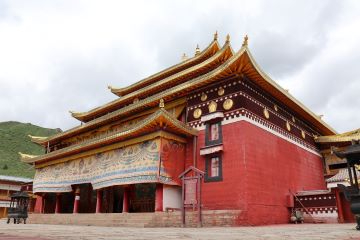Porcelain Ware the Qing Dynasty

Name in Chinese: 四川省博物院 Sì Chuān Shěng Bó Wù Guǎn [si tsuæ sen bɔ: wu: juæ]
Duration of Tour: Two Hours
Location: No.5, Qinghua Road, Qingyang District, Chengdu, Sichuan Province
Highlights: Ancient Sichuan Bronze Wares, Stone Carvings in the Han Dynasty, Ceramics, Lamaism, Buddhist Sculptures, Chinese Traditional Paintings and Calligraphy Works
Reputations: One of China’s Top-class Museums, the Biggest Museum in Southwestern China
Sichuan Provincial Museum was founded in 1941. It is situated near the famous Dufu’s Thatched Cottage and Qingyang Temple. The museum covers an area of 1.2 hectares(3 acres). It houses over 100,000 priceless antiques. Among the exhibits, 1,399 treasures have been added to the list of China’s Top-class Cultural Relics under Protection, and 6,731 antiques are the second-class. The exhibits include bronze articles, stone wares, ceramics, ancient coins, paintings and so on. The museum comprises ten sections or exhibition halls, namely the Bronze Wares of the Ancient Ba-shu Kingdoms, the Stone Carvings of the Han Dynasty, the Antique Ceramics, the Chinese Painting and Calligraphy Works, the Ethnic Culture of the Minorities in Sichuan, the Celebrated Painter Chang Dai-Chien’s Masterpieces, Buddhist Stone Carvings, Tibetan Buddhist Cultural Heritages, the Republican Revolution, and the Folk Artworks.
The Exhibition of Ancient Ba-shu Bronze Wares
Ba-shu refers to the Ancient Ba Kingdom(11th century B.C.-316 B.C.) and the Ancient Shu Kingdom(17th century B.C.-316 B.C.). The former occupied Chongqing and the Eastern Sichuan hilly region. The latter controlled the Sichuan Basin with its capital city in Chengdu. Both were destroyed by the Qin Kingdom in 316 B.C.. In the year of 221 B.C., the ruler of the Qin Kingdom unified the whole China, and established the first centralized feudal monarchy in Chinese history. The Terracotta Warriors in Xi’an was buried with the monarch. The Ancient Shu people highly developed the bronze smelting and casting technology. Since the world famous Sanxingdui Site was excavated, archaeologists have discovered many relic sites in Chengdu and the surrounding cities, such as Jinsha Site, the Twelfth Bridge Site, and Baodun Site. A large number of bronze wares were unearthed from the sites. The bronze wares of the Ancient Shu Kingdom are different from those which were found in central China, the Shang Dynasty(1600 B.C.-1100 B.C).
The Exhibition of the Han’s Stone carvings
The stone carving was popular in Sichuan Basin during the Han Dynasty(206 B.C.-220 A.D.). The carvings were used to decorate burial chambers. The patterns vividly depict all aspects of society during the Han Dynasty, such as plowing, dancing, playing musical instruments, riding horse-drawn carriages, outdoor dating, celebrating festivals, worshiping and trading.
The Exhibition of Ceramics
China’s country name suggests that China was the earliest china producer in the world. During the Neolithic Age, the inhabitants in the Yellow River Basin began to make pottery wares. A large number of pottery wares were also unearthed in Sichuan Basin. The emergence of porcelain production could be dated back to the Shang Dynasty(1600-1100 B.C.). It highly developed during the Eastern Han Dynasty(25-220), when the pottery firing and glazing techniques had attained a sufficient level for making high-quality porcelain wares. The porcelain manufacture and trade flourished during the period between the Tang Dynasty(618-907) and the Song Dynasty(960-1279). The renowned ceramic wares produced in the Tang and Song Period were the Tang Tri-colored Glazed pottery, the Ruyao Porcelain and the Jun Kiln Porcelain. The period between the Ming Dynasty(1368-1644) and the Qing Dynasty(1644-1911) was the climax of the porcelain production development. The representative ceramic product was the world famous “White and Blue Porcelain”.
The Exhibition of Lamaism
The west part of Sichuan was mainly inhabited by Tibetans. Sichuan Province is the second largest habitation of Tibetans in China. It is the home for 1.1 million Tibetan people. They live in Garze Tibetan Autonomous Prefecture and Aba Tibetan and Qiang Group Autonomous Prefecture. Most of Tibetans follow the teaching of Buddha. The Tibetan Buddhism is also known as Lamaism. The exhibitions depict the spread and development of Lamaism. The founder of Lamaism was Master Padmasambhava. In 750s, he introduced the Tantric Buddhism to Tibet and established the earliest lamasery, the Samye Lamasery. In the following centuries, Lamaism spread gradually to further regions, such as Sichuan Province, Qinghai Province, and Mongolia Plateau. Nowadays, it is not only popular among Tibetan people, but also other nationalities, for example, Yugu Ethnic Group, Mongolians and Monpa people. Tibetan Buddhism is divide into five schools, namely the Nyingma Lamaism, the Sakya Lamaism, the Kagyu Lamaism, Kadampa Lamaism and the Gelug Lamaism. Some Tibetans also believe in the Bonpo Religion.
The Exhibition of Chang Dai-Chien’s Masterpieces
The celebrated painter, Chang Dai-Chien was born in Neijiang Prefecture, Sichuan Province, in 1899. He went to Gansu Province in 1941, and copied the murals of the Dunhuang Grottoes. He spent two and a half years at the grottoes, and accomplished over 200 copies of the murals. After he came back from Dunhuang Grottoes, Chang Dai-Chien changed his painting style. Before he stated his hard job at Dunhuang Grottoes, the maiden figures he painted were quite slim. Affected by the murals of Dunhuang Grottoes, the portraits he drew looked plump. In 1950s, Chang Dai-Chien travelled around the world for mounting exhibition of his works. In 1963, he presented 183 of his works at Dunhuang Grottoes to Sichuan Provincial Museum. In the year of 1983, Chang Dai-Chien passed away in Taipei. He is well-known as the most talented painter of China in the 20th century.
Opening Hours:
9:00 A.M. --- 9:00 P.M. in Summer
9:00 A.M. --- 8:00 P.M. in Winter
Closed on Mondays
Related Articles:
Sanxingdui Site Museum
Jinsha Site Museum
Author: Tina Luo
Update:
